Attached files
| file | filename |
|---|---|
| 8-K - FORM 8-K - HOLLY ENERGY PARTNERS LP | c97611e8vk.htm |
Exhibit 99.1

| Holly Corporation Holly Energy Partners Raymond James - Investor Conference March 2010 |

| 2 Disclosure Statement Statements made during the course of this presentation that are not historical facts are "forward-looking statements" within the meaning of the U.S. Private Securities Litigation Reform Act of 1995. Forward- looking statements are inherently uncertain and necessarily involve risks that may affect the business prospects and performance of Holly Corporation and/or Holly Energy Partners, L.P., and actual results may differ materially from those discussed during the presentation. Such risks and uncertainties include but are not limited to risks and uncertainties with respect to the actions of actual or potential competitive suppliers and transporters of refined petroleum products in Holly's and Holly Energy Partners' markets, the demand for and supply of crude oil and refined products, the spread between market prices for refined products and market prices for crude oil, the possibility of constraints on the transportation of refined products, the possibility of inefficiencies or shutdowns in refinery operations or pipelines, effects of governmental regulations and policies, the availability and cost of financing to Holly and Holly Energy Partners, the effectiveness of Holly's and Holly Energy Partners' capital investments and marketing and acquisition strategies, the possibility of terrorist attacks and the consequences of any such attacks, and general economic conditions. Additional information on risks and uncertainties, to include integration of acquired assets risk, that could affect the business prospects and performance of Holly and Holly Energy Partners is provided in the most recent reports of Holly and Holly Energy Partners filed with the Securities and Exchange Commission. All forward-looking statements included in this presentation are expressly qualified in their entirety by the foregoing cautionary statements. Holly and Holly Energy Partners undertake no obligation to publicly update or revise any forward-looking statements, whether as a result of new information, future events or otherwise. |

| 3 Presentation Outline Overview of Holly and HEP Financial Performance Focused Growth Orientation Balance Sheet Highlights and Liquidity Conclusion |
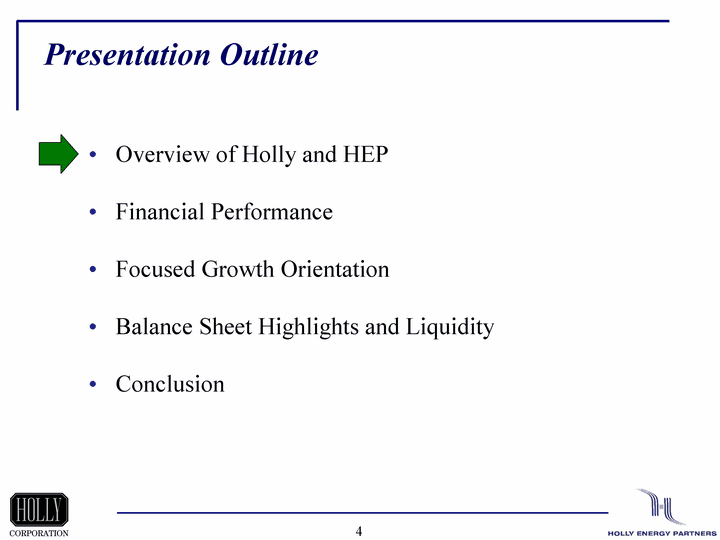
| 4 Presentation Outline Overview of Holly and HEP Financial Performance Focused Growth Orientation Balance Sheet Highlights and Liquidity Conclusion |

| 5 Holly Overview Holly Corporation: Holly's refineries operate in Southwest, Rockies & Mid-Continent markets 256,000 bpsd of refining capacity and weighted average complexity greater than 12.0 Refineries directly connected to Domestic or Canadian crude trading hubs Owns 100% of GP and 7.3 million LP units of Holly Energy Partners (NYSE: HEP) Holly Energy Partners: Approximately 2,500 miles (after sale of RGJV) of refined product & crude pipelines 11 Terminals & 3 loading rack facilities in 7 states (3 terminals co- owned) Over 4 million bbls of refined product & crude oil storage 25% interest in Salt Lake pipeline, a joint venture with Plains, delivering crude oil into the Salt Lake valley |

| 6 Holly Investment Highlights Pure Play Refiner 3 refineries with combined processing capacity of 256,000 barrels per day (bpd) 40 years of refining experience-entered refining business in 1969 (profitable every year) Competitive Assets High complexity facilities with access to multiple sources of crude supply High degree of crude source flexibility Attractive markets Geographic: Rocky Mountains, Southwest and Mid-Continent Product mix: Balanced product slate with added specialty lubricant products Capital projects with significant impact Reinvested approx. $500 million of cash flow generated in recent years into facilities Capital deployment has been focused on growth and optionality Synergistic Acquisition of Tulsa Refineries Low all-in cost for complex Mid-Con refineries Sinclair addition eliminates approximately $125 MM of regulatory required capital Provides additional market and product diversification Strong Financial Performance Industry leading return on invested capital & return on assets among peers Low debt among peers & history of conservative & disciplined financial management Experienced management Track record of reliability and profitability through multiple cycles Key operating executives average more than 20 years experience History of successful major project execution HEP ownership Stable cash flow quarterly from HEP through regular and incentive distributions 7.3 Million Common Units plus 100% of General Partner 1 - HEP's annualized cash distributions as of 2/1/10 to HOC exceed $34M for LP and GP ownership interests 1 |

| 7 100% fee based revenue business Long term contracts supporting revenue stream Proven track record of distribution increases No commodity ownership risk or related hedging Well maintained assets serving high growth markets Senior management team averages over 25 years of industry experience Benefits from Holly's refining growth plan HEP Investment Highlights |

| 8 Presentation Outline Overview of Holly and HEP Financial Performance Focused Growth Orientation Balance Sheet Highlights and Liquidity Conclusion |

| Historical EBITDA (in millions) Holly Corporation Gross Margin ($/bbl) Capacity (bpsd) $9.20 109 $12.62 109 $15.78 109 $16.74 111 $10.96 116 $7.21 256 Holly Energy Partners Pipeline Volume (bpsd) 95 159 189 205 276 338 1 1 - Capacity and pipeline volumes are based in thousands. 2 - On 12/1/09, we sold our 70% interest in Rio Grande. Results of operations of Rio Grande are presented in discontinued operations and pipeline volume information excludes volumes attributable to Rio Grande. 3 - 85,000 bpd of capacity was added in June 2009 based on the Sunoco refinery acquisition and another 40,000 bpd of capacity was added based on the Sinclair Refinery purchase in December 2009. 1, 3 1, 2 *Definition for non-GAAP measures such as EBITDA or Margins are located on page 23. 9 * * * |
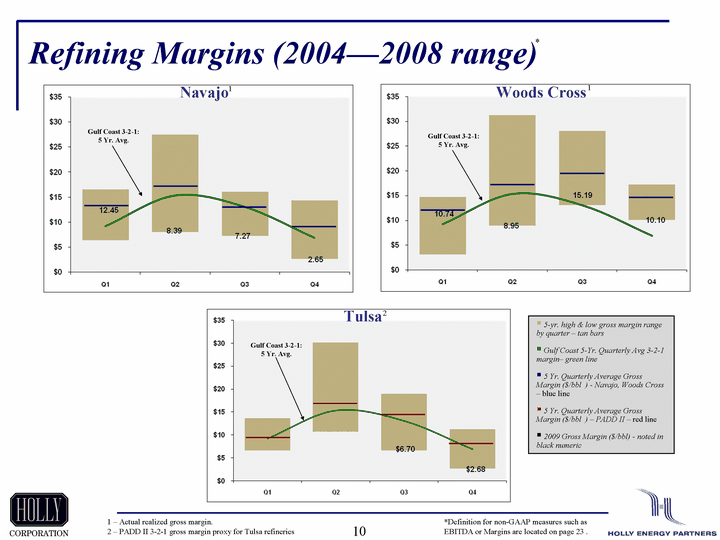
| 10 Refining Margins (2004-2008 range) 5-yr. high & low gross margin range by quarter - tan bars Gulf Coast 5-Yr. Quarterly Avg 3-2-1 margin- green line 5 Yr. Quarterly Average Gross Margin ($/bbl ) - Navajo, Woods Cross - blue line 5 Yr. Quarterly Average Gross Margin ($/bbl ) - PADD II - red line 2009 Gross Margin ($/bbl) - noted in black numeric Navajo Tulsa Gulf Coast 3-2-1: 5 Yr. Avg. Gulf Coast 3-2-1: 5 Yr. Avg. 1 - Actual realized gross margin. 2 - PADD II 3-2-1 gross margin proxy for Tulsa refineries 1 Woods Cross 1 2 *Definition for non-GAAP measures such as EBITDA or Margins are located on page 23 . Gulf Coast 3-2-1: 5 Yr. Avg. * |
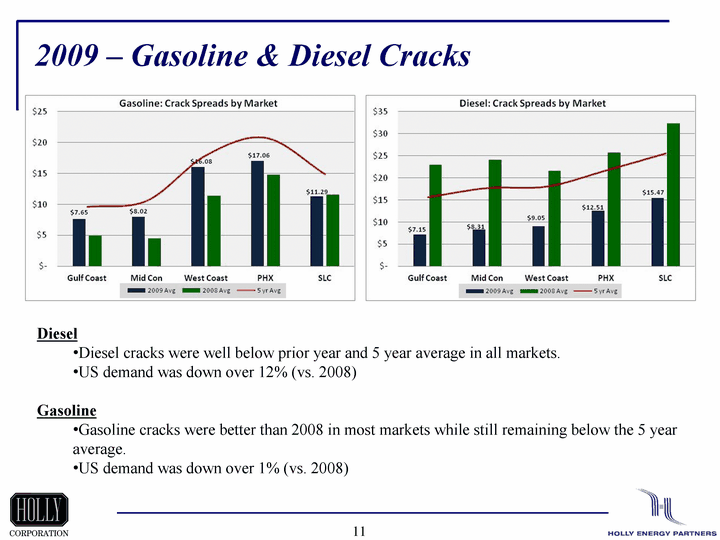
| 2009 - Gasoline & Diesel Cracks 11 Diesel Diesel cracks were well below prior year and 5 year average in all markets. US demand was down over 12% (vs. 2008) Gasoline Gasoline cracks were better than 2008 in most markets while still remaining below the 5 year average. US demand was down over 1% (vs. 2008) |

| 12 1 Jan '10 quarterly rate of $0.805/unit times 4 quarters equals $3.22 Annual Distributions per unit Current distribution (Jan'10) annual run rate: $3.221 HEP Distribution Growth |

| 13 Presentation Outline Overview of Holly and HEP Financial Performance Focused Growth Orientation Balance Sheet Highlights and Liquidity Conclusion |

| 14 Enhanced Competitive Position at Legacy Refineries Recently Completed Refinery Enhancements Increased capacity 19% Increased lower cost black wax and Canadian crude processing from 20 to 50% Increased ULSD production percentage Enhanced black wax and Canadian heavy receiving capabilities Increased capacity 17% (to 100,000 bpd) Allows 100% sour crude oil processing Increased ULSD production percentage Increased intermediates processing Provides access to Cushing crude oil hub and a variety of cost advantaged crudes Enables refinery to shift up to 40% of its crude slate to lower priced heavy crudes * * Crude unit work is mechanically complete. Navajo is planning to start processing heavy crudes in April 2010. |

| 15 Holly is in process of integrating the two Tulsa facilities (Sunoco & Sinclair) to form one complex 125,000 BPD refinery Net capex savings of approximately $125 million: Eliminates an estimated $110 million of project capital requirements Reduces MSAT 2 compliance capex by about $15 million Allows for immediate upgrade of existing gas oil production to gasoline/diesel without capital investment Approximately 12,000 bpd at $5/bbl WTI crack spread would produce $22 million per year in increased product value Eliminates future capital investment at Holly's existing Tulsa refinery of $100 million or more for gas oil upgrading facilities Integration will create combined facility with Nelson complexity of over 14.0 at 125,000 BPD Company wide capacity will be 256,000 BPD with weighted average complexity of greater than 12.0 Mid-2008 company wide capacity was 111,000 BPD Strategic Acquisitions at Historically Low Multiples 1 - Full integration could take up to 18 months but gas oil upgrade is available immediately 2 - Purchase price does not include inventory. $2,000 $1,186 $ / Complexity BBL $18,000 $11,325 $ / BBL of capacity High Average Refinery industry acquisitions over the last five years: 1 2 |

| 16 UNEV Pipeline & Refinery Economics Overview: 400 mile, 12" refined products pipeline from Salt Lake City to Las Vegas with terminals in Cedar City, UT and Las Vegas, NV Holly owns 75% interest (Sinclair 25%) Completion Date - Early 2011 Benefits: Las Vegas trades at premium to Salt Lake Lowers impact of seasonal demand reduction Provides access to growth market for Rocky Mountain refiners HEP Purchase Option: At completion of construction, HEP will have option to purchase HOC's interest in the pipeline JV for 180 days from completion of project at HOC's cost (estimated to be $206mm) plus a 7% per annum carrying cost |
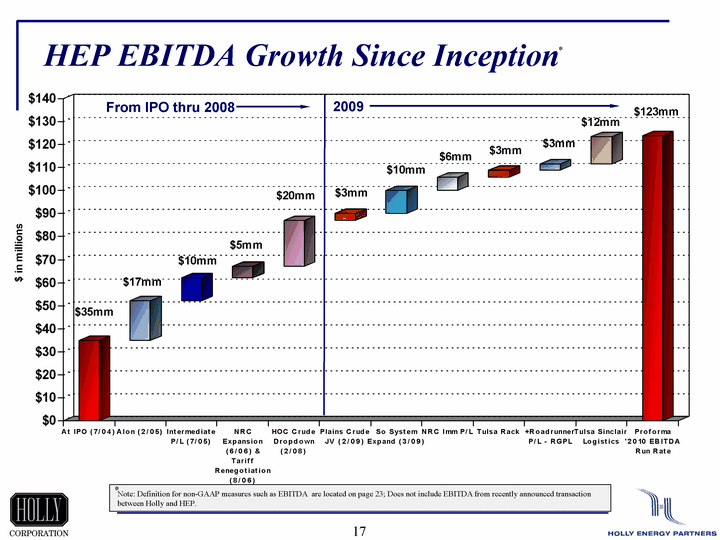
| 17 At IPO (7/04) Alon (2/05) Intermediate P/L (7/05) NRC Expansion (6/06) & Tariff Renegotiation (8/06) HOC Crude Dropdown (2/08) Plains Crude JV (2/09) So System Expand (3/09) NRC Imm P/L Tulsa Rack +Roadrunner P/L - RGPL Tulsa Sinclair Logistics Proforma '2010 EBITDA Run Rate East 35 35 52 62 67 87 90 100 106 109 111.5 124 17 10 5 20 3 10 6 3 2.5 12 From IPO thru 2008 2009 HEP EBITDA Growth Since Inception Note: Definition for non-GAAP measures such as EBITDA are located on page 23; Does not include EBITDA from recently announced transaction between Holly and HEP. * * |
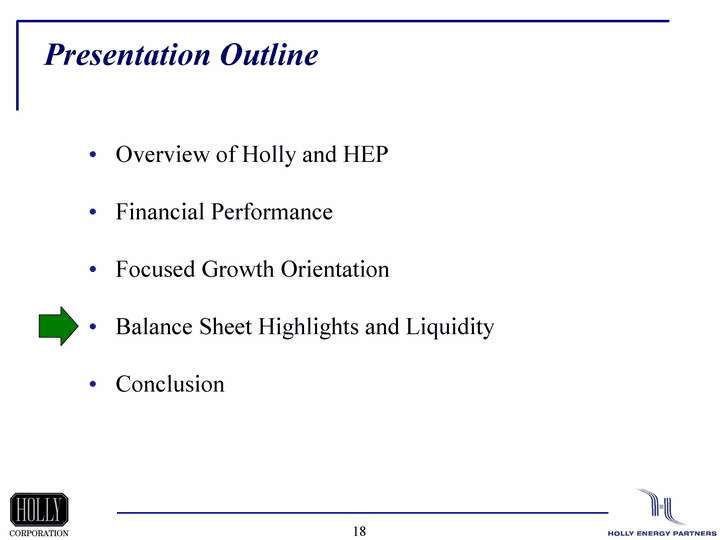
| 18 Presentation Outline Overview of Holly and HEP Financial Performance Focused Growth Orientation Balance Sheet Highlights and Liquidity Conclusion |
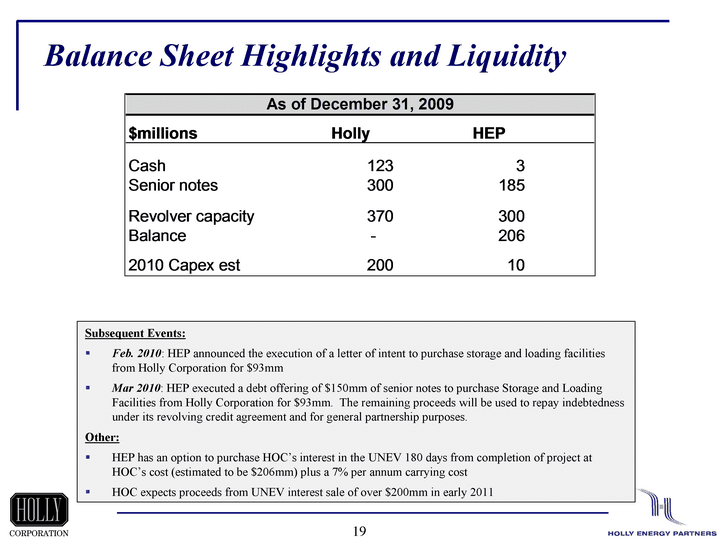
| 19 Balance Sheet Highlights and Liquidity Subsequent Events: Feb. 2010: HEP announced the execution of a letter of intent to purchase storage and loading facilities from Holly Corporation for $93mm Mar 2010: HEP executed a debt offering of $150mm of senior notes to purchase Storage and Loading Facilities from Holly Corporation for $93mm. The remaining proceeds will be used to repay indebtedness under its revolving credit agreement and for general partnership purposes. Other: HEP has an option to purchase HOC's interest in the UNEV 180 days from completion of project at HOC's cost (estimated to be $206mm) plus a 7% per annum carrying cost HOC expects proceeds from UNEV interest sale of over $200mm in early 2011 |

| 20 Presentation Outline Overview of Holly and HEP Financial Performance Focused Growth Orientation Balance Sheet Highlights and Liquidity Conclusion |
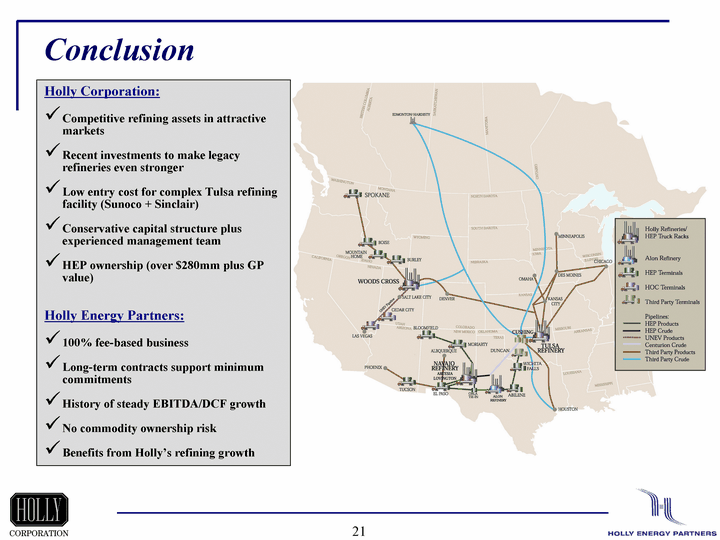
| 21 Conclusion Holly Corporation: Competitive refining assets in attractive markets Recent investments to make legacy refineries even stronger Low entry cost for complex Tulsa refining facility (Sunoco + Sinclair) Conservative capital structure plus experienced management team HEP ownership (over $280mm plus GP value) Holly Energy Partners: 100% fee-based business Long-term contracts support minimum commitments History of steady EBITDA/DCF growth No commodity ownership risk Benefits from Holly's refining growth |

| 22 Holly Corporation Holly Energy Partners 100 Crescent Court, Suite 1600 Dallas, Texas 75201 (214) 871-3555 Bruce R. Shaw, SVP-Chief Financial Officer M. Neale Hickerson, VP-Investor Relations www.hollycorp.com |
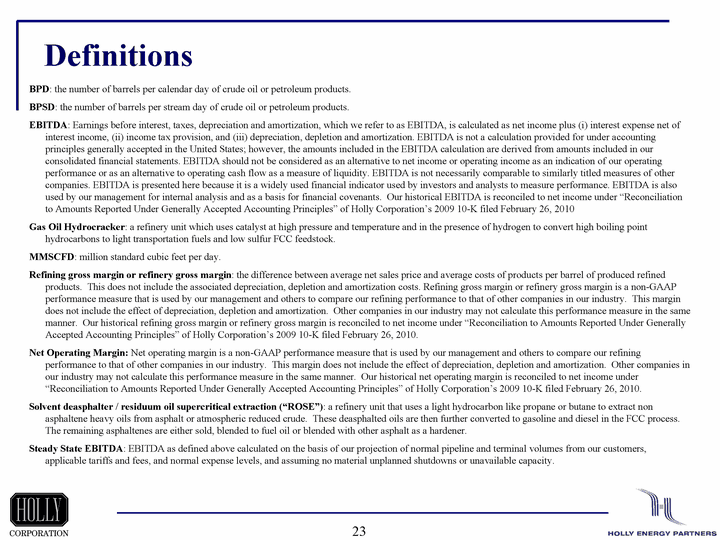
| 23 Definitions BPD: the number of barrels per calendar day of crude oil or petroleum products. BPSD: the number of barrels per stream day of crude oil or petroleum products. EBITDA: Earnings before interest, taxes, depreciation and amortization, which we refer to as EBITDA, is calculated as net income plus (i) interest expense net of interest income, (ii) income tax provision, and (iii) depreciation, depletion and amortization. EBITDA is not a calculation provided for under accounting principles generally accepted in the United States; however, the amounts included in the EBITDA calculation are derived from amounts included in our consolidated financial statements. EBITDA should not be considered as an alternative to net income or operating income as an indication of our operating performance or as an alternative to operating cash flow as a measure of liquidity. EBITDA is not necessarily comparable to similarly titled measures of other companies. EBITDA is presented here because it is a widely used financial indicator used by investors and analysts to measure performance. EBITDA is also used by our management for internal analysis and as a basis for financial covenants. Our historical EBITDA is reconciled to net income under "Reconciliation to Amounts Reported Under Generally Accepted Accounting Principles" of Holly Corporation's 2009 10-K filed February 26, 2010 Gas Oil Hydrocracker: a refinery unit which uses catalyst at high pressure and temperature and in the presence of hydrogen to convert high boiling point hydrocarbons to light transportation fuels and low sulfur FCC feedstock. MMSCFD: million standard cubic feet per day. Refining gross margin or refinery gross margin: the difference between average net sales price and average costs of products per barrel of produced refined products. This does not include the associated depreciation, depletion and amortization costs. Refining gross margin or refinery gross margin is a non-GAAP performance measure that is used by our management and others to compare our refining performance to that of other companies in our industry. This margin does not include the effect of depreciation, depletion and amortization. Other companies in our industry may not calculate this performance measure in the same manner. Our historical refining gross margin or refinery gross margin is reconciled to net income under "Reconciliation to Amounts Reported Under Generally Accepted Accounting Principles" of Holly Corporation's 2009 10-K filed February 26, 2010. Net Operating Margin: Net operating margin is a non-GAAP performance measure that is used by our management and others to compare our refining performance to that of other companies in our industry. This margin does not include the effect of depreciation, depletion and amortization. Other companies in our industry may not calculate this performance measure in the same manner. Our historical net operating margin is reconciled to net income under "Reconciliation to Amounts Reported Under Generally Accepted Accounting Principles" of Holly Corporation's 2009 10-K filed February 26, 2010. Solvent deasphalter / residuum oil supercritical extraction ("ROSE"): a refinery unit that uses a light hydrocarbon like propane or butane to extract non asphaltene heavy oils from asphalt or atmospheric reduced crude. These deasphalted oils are then further converted to gasoline and diesel in the FCC process. The remaining asphaltenes are either sold, blended to fuel oil or blended with other asphalt as a hardener. Steady State EBITDA: EBITDA as defined above calculated on the basis of our projection of normal pipeline and terminal volumes from our customers, applicable tariffs and fees, and normal expense levels, and assuming no material unplanned shutdowns or unavailable capacity. |
